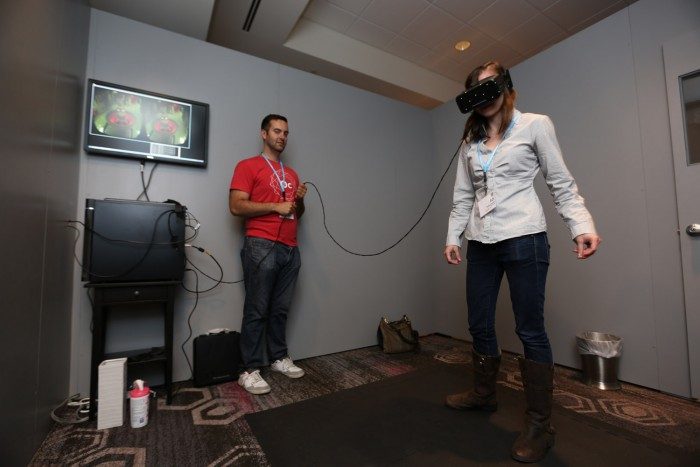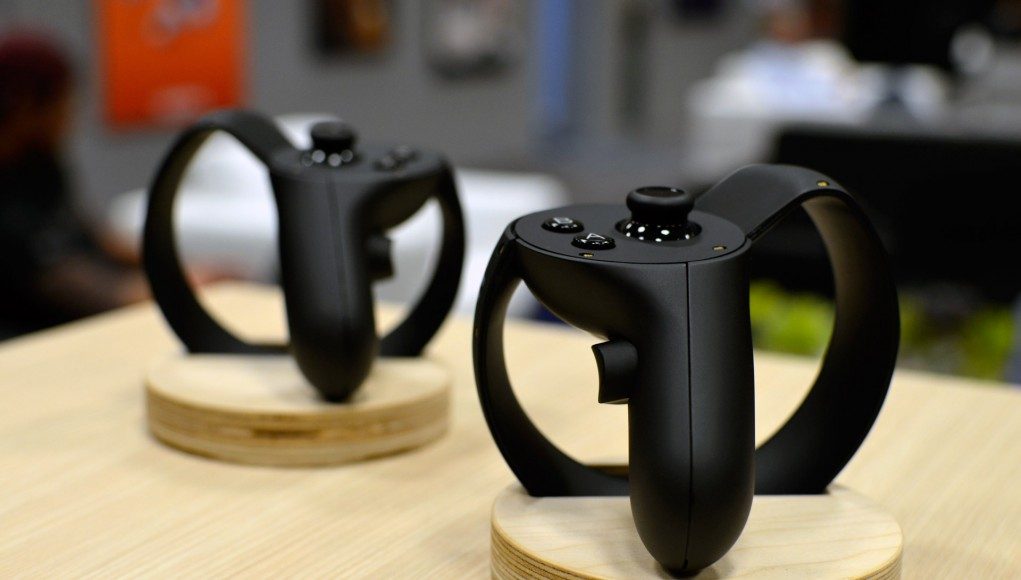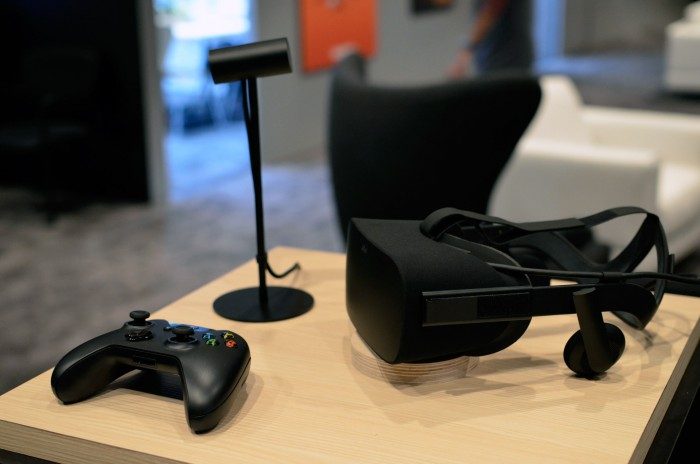Much praise has been lavished on Valve’s ‘room-scale’-capable Lighthouse tracking system, which affords users an impressively large tracking volume for virtual reality interaction. Not to be outdone, Oculus demonstrated to us at E3 2015 that their own tracking technology is capable of a similarly sized tracking area, and says that they aren’t emphasizing room-scale VR because of feasibility constraints, not technical ones.
At E3 2015 I got to see the new Oculus Touch VR controllers for the first time. I’m very impressed with the design, and think that right now they take the cake over any other motion input controller in terms of ergonomics. But tracking performance and volume is also important in evaluating which solution is best. We knew Oculus would nail tracking, given that their ‘Constellation’ system has been well demonstrated since the DK2 developer kit, but the company has never shown large volume experiences with their headsets, until now.
See Also: Hands-on – Oculus Touch is an Elegant Extension of your Hand for Touching Virtual Worlds
After Oculus founder Palmer Luckey jumped into the company’s multiplayer Toybox experience to show me the ins and outs of what the controller can do, he took a few minutes to demonstrate the tracking volume achievable with two of the company’s positional tracking cameras mounted on a wall just a few feet away from each other.
Apologies for the poor camera angle, restrictions on filming the screen necessitated a less than ideal view.
In the video above, I’m seeing Luckey opposite me in a virtual room (in reality he’s in the room next door on an identical setup); he’s walking me about the room, telling me to feel the extent of the tracking space, which goes up to the walls on the left, right, back, and quite near the forward wall of the 12×12 foot room. Indeed, the tracking held its impressive performance throughout most of the room even though Luckey said that the E3 setup was not positioned to maximize tracking volume (I did note some jumps when I reached all the way down to the ground to pick up some fallen objects).
Back when Oculus first debuted positional tracking with their DK2 development kit, the company was still only showing seated VR experiences. They first showed standing experiences when they revealed the Rift ‘Crescent Bay’ prototype in 2014, but have ever since demonstrated the system with a 5×5 foot (or so) mat on the ground and designed their demo experiences around that space.

But Oculus says that the reason the company hasn’t emphasized ‘room-scale’ experiences is not because their tracking technology can’t support it; rather because developers need a large target demographic, and adding the requirement of ‘users who have a room-scale space for VR’ limits that target too much for the current VR ecosystem.
Luckey elaborated more on the subject of room-scale tracking in our E3 2015 interview with him.
“The system may match [Lighthouse] in terms of capabilities, but we’re not trying to push that as something for developers to do. Most of the developers we’ve talked to don’t want to limit their audience beyond a subset of a subset of a subset of users,” he said. “You have people who have PCs that are powerful enough to run VR (or willing to buy one), then of that set, people who are interested in virtual reality. [Developers] don’t want to narrow it then down to people who want to clear out large spaces in their homes.”
Luckey says that many in the company’s developer community are wary of creating VR experiences that work best in a room-scale space, as it may scare off potential users who don’t want a reduced experience compared to one that’s been optimized for a more manageable space.
“The [~5×5 foot] mat that we have in that room is kind of representative of where we’ve seen developers developing stand-up experiences, allowing you to take a step or two in any direction or spinning around,” he said.
Regarding the limitations of Oculus’ tracking system vs. that of others, Luckey lumped systems together based on their tracking tech.
“It’s not necessarily a technological limitation, I mean all these optical systems have similar limitations in terms of occlusion and in many cases range. It all comes down to what developers are going to make, and we’re not trying to push people to make large room-scale experiences.”
But that doesn’t mean that such experiences won’t exist. There will be a fraction of people who want large scale experiences, says Luckey.
“There’s going to be devs making super cool [room-scale] stuff, I’m gonna have a VR room in my house, but it’s not something that most developers we’ve talked to are excited about doing.”
Room-scale tracking will most likely require two of the company’s positional tracking cameras for a reasonable level of tracking performance. While the Oculus Rift consumer version will have a single camera in the box, one option may be to bundle another camera with the company’s (presumably) separately sold Touch controllers, providing a second camera for those who do want a room-scale VR setup.
Luckey however noted that the company hasn’t yet locked down which of their products might be bundled together, saying that “we’re optimizing for a one-camera system out of the box; you take the Rift, set up one sensor, and cover a wide area that lets them play primarily with the bundled [Xbox] gamepad right now.” He wouldn’t yet commit whether or not the company will recommend two or more cameras for Touch.








